I hope everybody had a wonderful semester. This class taught me about critical, pressing issues that are affecting students in our world today. No matter the profession one takes, this class provides useful insight into the lives of our future presidents, doctors, lawyers, and more. Not only that, we were able to learn more about our mears, and about professional technology. This has been a great semester and I’m so proud to be finishing this class!
Parent Communication; the key to to student success
Creating a connection between the home and school environments is such a vital part of being a teacher. It allows students to know that their guardians are supporting them in their studies and that their teachers support them at home. Edutopia provides a list of 20 things a teacher can do to establish this much-needed connection, both in what to do and how to do it. Asking parents and providing praise while smiling and having positive body language can begin a profitable and effective working relationship to support the student (Aguilar, 2011). This “how” of the connection makes me think back to the school board meeting I attended on March 7th, 2024. At the beginning of the meeting, the elected officials spent some time watching the High school’s production of “Frozen” and they commented on it to encourage the students. One of the parents in attendance expressed how happy it made her that they attended a part of the show, and how it felt like the Board cared about their children and their successes, not just their hardships. Additionally, they discussed a change of the bus routes so fewer children will have to cross Sunrise Highway to walk to school. This comes after years of parents expressing their dislike of this practice to the board. They were heard and there was change acted on. This is why communication is so important.
One of the ways I intend to communicate with the families of my students was listed in the video “9 Ways to Communicate with Parents for Teachers // INCREASE parent communication!”, though I actually had this idea myself at the beginning of the semester (Vestal’s 21st Centory Classroom, 2021). I will create a classroom website containing all the required material such as syllabus and rubrics, as well as homework, grades, and self-care modules. Having all the classroom information in one space will relieve stress for the students, and having it accessible to the parents ensures that they are kept in the loop with their child’s learning. Additionally, I will be using something similar to the Remind app, a platform that allows for fast and effective communication between parents, students, and teachers, a trio I find very important.
Refrences
Aguilar, E. (2011, September 23). 20 Tips for Developing Positive Relationships with Parents. Edutopia. https://www.edutopia.org/blog/20-tips-developing-positive-relationships-parents-elena-aguilar
Vestal’s 21st Centory Classroom (2021, August 22). 9 Ways to Communicate with Parents for Teachers // INCREASE parent communication!
. YouTube. https://youtu.be/8aHJkRXgbcE
Social Media and Education; Should it be in the Classroom?

Image created by Bassey, A. using wordclouds.com
I believe there is space for social media in the lives of children and teenagers, but I do not think it belongs in a school. Cellphones can be fun, and provide entertainment for children, but there are serious mental health risks that come with them. According to NPR, “Young people who report spending the most time on smartphones — five to seven hours a day — are twice as likely to report being depressed as those who use their phones for one to two hours a day” (Kamenetz, 2019). The severe risks that come with extensive technology use are too powerful to ignore. What students do outside of the school is up to their parents and them, but in a school, there is no way to control what they are seeing and doing, and how it affects them.
Aside from the passive risks of social media causing depression and anxiety, it is also likely to introduce students to the world of cyberbullying. An example is Ronan Parke, the runner-up on Britain’s Got Talent. When exposed to the media at age, he began to be cyberbullied really bad by fans of the show. It got to the point that he had to get off social media and have a group of people run his accounts for him (Willett, 2019). He was one of the lucky ones, however. Many children who experience cyberbullying don’t have someone to turn to who can help or are afraid to seek it out, so they suffer in silence. It used to be that children who were bullied in school could get away from it at home, but now with social media, it can follow them. Cyberbullying can lead to less attendance, struggles with classwork and attention, and problems arising between students or even teachers (Likes vs. Learning: The Real Cost of Social Media for Schools, 2023) In some extreme cases, cyberbullying can lead to suicide.
While I see the argument that cell phones can bring students fun and calm them down, from personal experience, that is simply a disguise. In reality, cell phones and social media cause a dissociative effect, disconnecting their users from reality and forcing emotions to go blank, repressing them (McQuate, 2022). It’s not calming, it’s harmful. While there is a time and place for this, it is not in a school. It can be good for a brain break after school, or while winding down for the night, but during school, students should be focused and on top of their work, not floating in their own minds.
Resources
Kamenetz, A. (2019, August 27). NPR’s The Scientific Debate over Teens, Screens, and Mental Health. National Public Radio. Link
Likes vs. Learning: The Real Cost of Social Media for Schools. (2023). American Federation of Teachers. https://www.aft.org/sites/default/files/media/documents/2023/LikesVSLearning_Report.pdf
McQuate, S. (2022, May 23). “I don’t even remember what I read”: People enter a “dissociative state” when using social media. UW News. https://www.washington.edu/news/2022/05/23/people-enter-a-dissociative-state-when-using-social-media/
Willett, R. (Director). (2019). Plugged-In: The Toxicity of Social Media Revealed. [YouTube Video]. Brick in the Wall Media.
Hallucinogens; Lesson Review
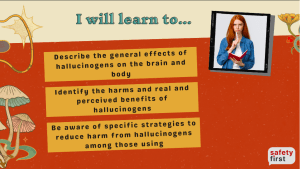
For this blog post, I reviewed “Lesson Number 10: Halucinigens” from Stamford Medicine, Safety First. In this lesson, the instructor can cover known Hallucinogens and their effects, talk about why people use these drugs, and discuss certain harm reduction activities that can be done if the drug is in use. It is a Canva PowerPoint slide covering all these topics, as well as a pre-made Kahoot, talking points, and guided discussion. The lesson is strong in delivering information. It covers in-depth explanations of different drugs. It contains strong descriptions of risk factors which can be useful for students to know to deter them from trying the drug out. It is a well-put-together lesson with clear guidelines for teaching. I would say its weakness is that it would not be a good lesson for grades K through 8. It is geared more towards a secondary school level, but it would have been nice for the language to be simplified for a younger grade level, or a modified version for them could have been a possibility. There is alot of higher-level reading knowledge needed to understand this lesson. One way I would improve on this lesson may be in a culturally responsive way. There is only one short slide explaining why hallucinogens may be used in cultural or religious ways. I would go into a bit more detail. Students may be confused about the WHY of different groups assuming the risks for religious reasons, and I would not be afraid to go into this. Not only does it encourage education about different cultures, but it also may answer their unanswered questions.
References
Halpern-Felsher REACH Lab. (n.d.). Safety First – Lesson 10. Stanford Medicine. https://med.stanford.edu/halpern-felsher-reach-lab/preventions-interventions/Safety-First/safety-first-lesson-10.html
Mindfulness; A Helpful Practice

Image created by Bassey, A. using wordclouds.com
Resources
Linehan, M. (2015). DBT skills training handouts and worksheets (Second). The Guilford Press.
Long, R. (director/ producer). (2012) Room To Breathe [film]. ZAP Zoetrope Aubry Productions.
Schwartz, K. (2019). Nine ways to ensure your mindfulness teaching is trauma informed. KQED Mindshift. Link
Why is Mindfulness Needed in Education. (n.d.). Mindful Schools. Link
Community Comparison, Getting Started
| Data Points | Massapequa | Freeport |
| Number of Students * | 6477 | 6342 |
| Chronic Absenteeism | Grades 1-8: 12%
High School: 19.3% |
Grades 1-8: 23.8%
High School: 21.1% |
| English Language Proficiency | 0.4% ELL | 17.8% ELL |
| 4 Year Graduation Rate * | 98% | 82% |
| Standardized Test Scores * (ELA and Math, include % taking the tests) | %students who scored at a proficient level in ELA and Math, respectively
Grade 3- 46%, 68% Grade 4- 54%, 74% Grade 5- 44%, 70% Grade 6- 61%, 72% Grade 7- 73%, 81% Grade 8- 75%, 67% |
%students who scored at a proficient level in ELA and Math, respectively
Grade 3- 43%, 59% Grade 4- 42%, 63% Grade 5- 25%, 36% Grade 6- 46%, 43% Grade 7- 28%, 31% Grade 8- 45%, 17% |
| Accountability Status* | Local Support and Improvement | Local Support and Improvement |
| % Inexperienced Teachers | 13% | 17% |
| Ethnicity * | 86% White Students
9% Hispanic/Latino Students 3% Multiracial Students 2% Asian/Hawaiian/ Pacific Islander Students 1% African American Students 0% Naive American Students |
4% White Students
71% Hispanic/Latino Students 2% Multiracial Students 1% Asian/Hawaiian/ Pacific Islander Students 21% African American Students 0% Naive American Students |
| Median Household Income | $148,295 | $109,390 |
| Average Property/School Taxes | 2.2% | 2.2% |
| Average Home Price | $740,000 | $510,000 |
I was not surprised to see the ethnic differences between Massapequa and Freeport’s school districts. However, what surprised me the most was the average test scores being significantly lower in Freeport. I tried to see why that is by comparing the amount of inexperienced teachers, but the statistics were fairly similar. I feel like I already knew houses cost less in Freeport, but I did not know how drastic the difference was.
Homelessness: An Unfair Truth
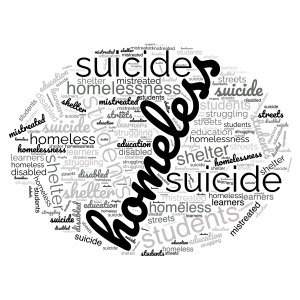
Image created by Bassey, A. using wordclouds.com
One theme I identified from the documentary was the extreme loneliness homeless students can go through. I saw it in Roque. He said that he experiences extreme loneliness and that he doesn’t need to rely on anybody else, because he has himself (DeMare, Kelly, and Taber, 2014). This was seen with many other homeless students in the film, such as a lesbian student who was kicked out and mistreated by her family. This serious self-reliance can lead to anxiety, depression, or thoughts of self-harm or suicide. According to the National Healthcare for the Homeless Council, “more than half of people experiencing homelessness have had thoughts of suicide or have attempted suicide” (Suicide and Homelessness, 2018). A book for young children that may help broach this topic is called “When Sadness is at Your Door”. It is a book that personifies sadness and explains ways to tackle it in simple terms, like coloring, taking time for yourself, and engaging with people who care about you (Eland, 2019). This book can be helpful for homeless children who are experiencing loneliness and sadness.
Another theme I identified in the reading is that the definition for students who are homeless is those who do not have “a fixed, regular, and adequate nighttime residence” (Mc-Kinney Vento Homeless Education, 2021). This includes such a wide group of students, including those who live with another family, in a shelter, in a vehicle, or on the streets. Additionally, a large majority of these students are disabled or are English Language Learners, making it even more difficult for students to learn. There is a song called “The A-Team” by Ed Sheeran. It was written about a girl in a homeless shelter struggling to make ends meet (Sheeran, 2010). It shows that there are so many different situations for homeless youth to be in, that we as teachers need to be aware and observant of.
Resources
De Mare, A., Kelly, K., & Taber, K. (Producers), & De Mare, A., & Kelly, K. (Directors). (2014). The homestretch [Streaming video]. United States: Bullfrog Films.
Eland, E. (2019). When sadness is at your door. Random House Children’s Books.
Mc-Kinney Vento Homeless Education. (2021). New York State Education Department. http://www.nysed.gov/essa/mckinney-vento-homeless-education
Sheeran, E. (2010, April 22). Ed Sheeran – the A team [official music video]. YouTube. https://www.youtube.com/watch?v=UAWcs5H-qgQ
Suicide and homelessness. National Healthcare for the Homeless Council. (2018, May). https://nhchc.org/wp-content/uploads/2019/08/suicide-fact-sheet.pdf
BPD- A deadly Stigma
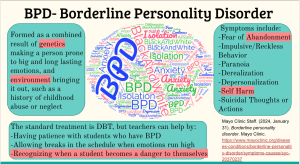
I debated writing this a lot. BPD is one of, if not the most, highly stigmatized illnesses, both physical and mental. However, I feel it will only enhance people’s understanding and acceptance of it if I tell my story, so I will. I have Borderline Personality Disorder, and it makes my day-to-day life very different from other people’s. I am often told I am being too dramatic, or that I am blowing things out of proportion. The truth of it is, I have very big feelings that go from 0 to 100 very quickly. My emotions come on faster than others, and it takes much longer for them to go away. Additionally, my emotions are often wildly larger than a situation warrants, making the feelings worse. Finally, I am more likely to act on my emotions impulsively than wait and think it out. I experience these symptoms mostly through anxiety and depression. I am grateful to have been enrolled in a Dialectical Behavioral Therapy course which taught me how to safely manage my symptoms and control them, rather than let them control me.
Some people experience the symptoms through anger, and that is part of the reason this illness is so stigmatized. Sometimes, people who suffer from this can have radical outbursts of anger, becoming a threat to themselves or others. While that is a reality of the disease, it is such a small percentage of people who experience it that way. We are called crazy, irrational, and violent for what makes up a very small minority of people. Most who have it have it the way I do, where the fear of abandonment is so great, it ends up pushing people away. Most suffer in silence, modulating their emotions to what may seem to others to be the “normal” amount, and as a result, end up repressing their emotions to a dangerous level.
70% of people living with BPD will attempt suicide in their lifetime. 10% will succeed (2024) Such a high stigma means people are less likely to seek out help and can fall victim to themselves. As a teacher, it is so important to know the warning signs of suicide. A big part of BPD is being impulsive; these decisions can happen quickly. Intervening at the right time can mean the difference between life and death.
Mayo Clinic Staff. (2024, January 31). Borderline personality disorder. Mayo Clinic. https://www.mayoclinic.org/diseases-conditions/borderline-personality-disorder/symptoms-causes/syc-20370237
NYP-bpd-borderline personality disorder (bpd)-understanding BPD: NYP. NewYork-Presbyterian. (2024). https://www.nyp.org/bpdresourcecenter/borderline-personality-disorder/understanding-bpd#:~:text=Research%20has%20shown%20approximately%2070,disorder%20and%20the%20general%20population
Cyberbullying, The Hidden Killer
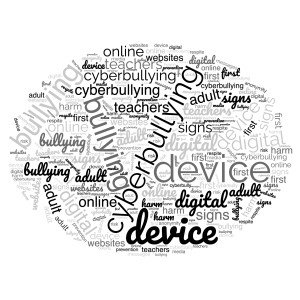 Image created by Bassey, A. using wordclouds.com
Image created by Bassey, A. using wordclouds.com
https://flip.com/s/8y_QngvBWeRt
References:
- Dupej, H. & Embry, M. (2020). Dark cloud: The high cost of cyberbullying. TELUS Wise
- The power of words. Common Sense Education. (2018, August). https://www.commonsense.org/education/digital-citizenship/lesson/the-power-of-words?check_logged_in=1
- Tips for Teachers: Warning Signs a Child is Being Cyberbullied or is Cyberbullying. (2021, May 21). stopbullying.gov. https://www.stopbullying.gov/cyberbullying/tips-for-teachers
- Wilkey Oh, E. (2019, March 25). Teachers’ Essential Guide to Cyberbullying Prevention. Common Sense Education. https://www.commonsense.org/education/articles/teachers-essential-guide-to-cyberbullying-prevention
School Violence: A Tragic Reality
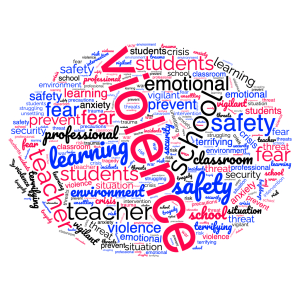
Image created by Bassey, A. using wordclouds.com
As a teacher, grappling with the idea of school violence is an unsettling reality that weighs heavily on my mind and impacts various aspects of my professional life. I do not want to be walking into a war zone every time I go to work, but I do it because I am passionate. There is a legitimate fear that came over me when I was watching the documentary, and a student admitted to making a 5-gallon bucket of napalm (Moore, 2002). It’s terrifying to me that people like that exist, and what’s more, he was mad he wasn’t the number one threat to the school; he was only number two. I could not imagine what number one did. The potential ramifications of school violence are profound and multifaceted, extending beyond mere physical safety to encompass emotional well-being, professional responsibilities, and the overall learning environment.
First and foremost, the safety and security of my students are paramount concerns. I would like to teach high school students, so they are old enough to understand the prevalence of this issue. That can make the situation heightened with emotion, creating a more dangerous issue. The thought of facing a crisis situation such as an active shooter scenario is a terrifying prospect that I must be prepared to confront but terrifies me to my core. In just the first four days of 2024, there were already 7 school shootings that resulted in people being killed or injured (School Shootings This Year?: How Many and Where?, 2024) Implementing safety protocols, participating in active shooter drills, and remaining constantly vigilant for signs of potential threats are all necessary precautions that I must take to protect my students and myself.
Moreover, the pervasive threat of school violence casts a shadow over the classroom environment, creating an atmosphere of fear and anxiety that can hinder the teaching and learning process. Nurturing a sense of trust and security among my students is essential for fostering a positive learning environment where they feel empowered to thrive academically and emotionally. Additionally, the emotional toll of school violence weighs heavily on me as an educator. The fear and trauma associated with incidents of violence can leave a lasting impact on students and staff alike, making it challenging to maintain a sense of normalcy in the aftermath. Providing emotional support and guidance to students who may be struggling to cope with feelings of fear or anxiety is a crucial aspect of my role as a teacher. Studies have shown that the use of social-emotional learning techniques not only can help after violence has happened but can prevent it from happening at all. A boy in Alaska turned in his own gun to a teacher after using SEL skills with a friend, preventing a tragedy (Vogel, 2008). As a teacher, I will absolutely be implementing SEL techniques in my classroom, especially knowing what they can do to prevent violence.
Furthermore, the prevalence of school violence necessitates ongoing dialogue and collaboration with colleagues, administrators, and community stakeholders to address underlying issues and implement effective prevention strategies. To quote from the CDC, “All students have the right to learn in a safe school environment…school violence can be prevented” (Preventing school violence, 2019) Engaging in discussions about school safety, advocating for policy changes on a local, state, and national level, and participating in professional development opportunities focused on crisis intervention are all ways in which I can contribute to efforts to mitigate the risk of violence in schools.
In conclusion, the specter of school violence looms large in my role as a teacher, impacting my sense of safety, the classroom environment, and my emotional well-being. By remaining vigilant, fostering a supportive learning environment, and actively participating in efforts to prevent violence, I strive to create a safer and more secure environment for my students and myself.
References
- Moore, M. (Producer & Director) (2002). Bowling for Columbine [Film]. United States: Dog Eat Dog Productions/ YouTube https://watchdocumentaries.com/bowling-for-columbine/
- Preventing school violence. (2019). Centers for Disease Control and Prevention. https://www.cdc.gov/violenceprevention/youthviolence/schoolviolence/fastfact.html?CDC_AA_refVal=https%3A%2F%2Fwww.cdc.gov%2Fviolenceprevention%2Fyouthviolence%2Fschoolviolence%2Findex.html
- School Shootings This Year?: How Many and Where?. (2024, January 18). Education Week. https://www.edweek.org/leadership/school-shootings-this-year-how-many-and-where/2024/01
Vogel, T. (2008, February 26). Creating a safe place: Lessons on managing emotions pay off. Edutopia. https://www.edutopia.org/social-emotional-learning-across-curriculum